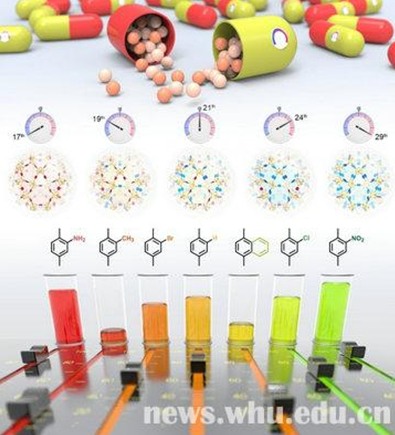Prof. Deng Hexiang and his team published online the results of their innovation research in Journal of the American Chemical Society (JACS), a top international publication in chemistry, initiating a new method to program the release of single or multiple drug molecules.
Targeting at the drug delivery requirements of patients, this method can accurately design the release rate of drugs and the time to reach the release peak. The "programmable" new nano drug carrier provides a new tool for personalized and customized medical treatment.
The thesis is titled Multivariate Metal-Organic Frameworks for Dialing-in the Binding and Programming the Release of Drug Molecules, with Prof. Deng Hexiang as its corresponding author and PhD. Dong Zhiyue from the College of Chemistry and Molecular Sciences, as its first author. Prof. Zhang Xianzheng, Sun Yangzesheng, an undergraduate and Chu Jun, a graduate, are the co-authors.
Generally, the dynamics of drug release is determined by the host-guest interactions between drug molecules and the carrier materials. The activation energy required to overcome the host-guest interaction is usually discrete, thus the drug release profiles are hardly controllable in a precise manner. In this research, the researchers adopt Metal-Organic Frameworks (MOF) as the new carriers of the drug molecules and introduce multiple organic functional groups into the structure to construct multivariate Metal-Organic Frameworks (MTV-MOF). Because the interactions between each functional group and drug molecules can be quantified respectively, the interactions between MTV-MOF and drug molecules can be precisely controlled through the various combinations of functional groups and components. Therefore, the release profile of guest molecules can be tuned in a precise manner and over a wide range (regulatory amplitude up to 32 fold).
In addition, the host-guest interaction is quantified by the researchers. Deng’s group has developed a new method for quantifying the interactions between materials and guest molecules, especially the weak interaction (such as static electricity, hydrogen bond, π-π interaction and Van der Waals force) between the host and the guest. Through the continuous control of porous chemical environment at a molecular level, the researchers realize the programmed drug release process for the first time.
It is noteworthy that this method not only works on single drug molecules, but also applies to the delivery of multiple drugs, to tend to the actual need of patients in a programmable way.
Since Deng joined Wuhan University four years ago, he has dedicated to the research and development of multi-component porous crystalline materials and made achievements in fields of energy and health care. He is the author of several high-quality papers as corresponding author, including 4 JACS. The success of this innovation research has also been the second major achievement of UC Berkeley-Wuhan University Joint Innovative Center since its establishment 4 months ago.
This research was supported by the 1000 Talent Plan of China, National Natural Science Foundation of China, National Science Foundation of Jiangsu Province and Suzhou City, Key Program of Hubei Province, Suzhou Institute of Wuhan University and Innovation Team of Wuhan University.

Rewritten by Zheng Lingling
Edited by: Shen Yuxi, Hu Sijia


